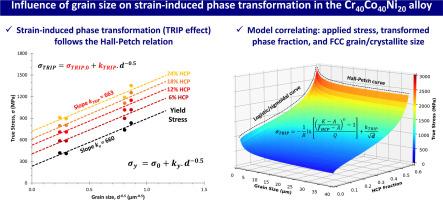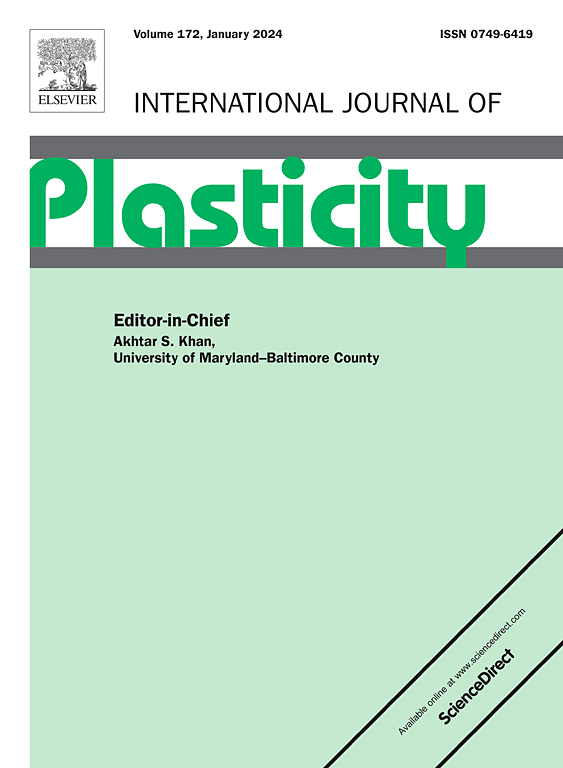Influence of grain size on strain-induced phase transformation in a CrCoNi multi-principal element alloy
IF 9.4
1区 材料科学
Q1 ENGINEERING, MECHANICAL
引用次数: 0
Abstract
A Cr40Co40Ni20 (at.%) alloy with different grain/crystallite sizes was analyzed through in-situ synchrotron X-ray diffraction during tensile testing. The FCC starting structure underwent a partial strain-induced transformation to HCP (TRIP effect) and the percent transformed was measured throughout the deformation. The critical stress required to form a certain HCP fraction was shown to follow a Hall-Petch relation (σTRIP = σTRIP,0 + kTRIPd-0.5), with the Hall-Petch slope being approximately the same for yield stress and TRIP effect (ky ≈ kTRIP). Furthermore, this work developed a Hall-Petch-based model that correlates the applied stress, the transformed phase fraction, and the initial FCC grain/crystallite size. It predicts the stress required to form a certain HCP fraction, or the fraction formed when a certain stress is applied, for different grain/crystallite sizes. We also proposed a mechanism to explain the grain/crystallite size dependence of the TRIP effect and discuss how the TRIP effect and its early activation in the Cr40Co40Ni20 alloy provide high work-hardening capacity, which improves ductility and toughness. Here, a refined FCC grain size (d = 1.3; c = 0.7 μm) was shown to increase the yield stress by at least 100 % (417 → 834 MPa), compared to a coarser grain material (17; 6.8 μm), while maintaining a high ductility of 41 %. This work contributes to a better understanding of the deformation mechanisms, mainly the strain-induced phase transformation (TRIP), highlighting their impact and importance on mechanical properties.


晶粒尺寸对铬钴镍多主元合金中应变诱导相变的影响
在拉伸测试过程中,通过原位同步辐射 X 射线衍射分析了具有不同晶粒/结晶尺寸的 Cr40Co40Ni20 (at.%)合金。FCC 初始结构经历了部分应变诱导的 HCP 转变(TRIP 效应),并在整个变形过程中测量了转变的百分比。研究表明,形成一定 HCP 部分所需的临界应力遵循霍尔-佩奇关系(σTRIP = σTRIP,0 + kTRIPd-0.5),屈服应力和 TRIP 效应的霍尔-佩奇斜率大致相同(ky ≈ kTRIP)。此外,这项工作还开发了一个基于霍尔-佩奇的模型,该模型将施加应力、转化相分数和初始催化裂化晶粒/晶粒尺寸相关联。该模型预测了在不同晶粒/结晶尺寸下形成特定 HCP 分数或施加特定应力时形成的分数所需的应力。我们还提出了一种机制来解释 TRIP 效应的晶粒/晶粒尺寸依赖性,并讨论了 TRIP 效应及其在 Cr40Co40Ni20 合金中的早期激活如何提供高加工硬化能力,从而改善延展性和韧性。研究表明,与较粗的晶粒材料(17;6.8 μm)相比,细化的 FCC 晶粒大小(d = 1.3;c = 0.7 μm)可将屈服应力提高至少 100%(417 → 834 MPa),同时保持 41% 的高延展性。这项研究有助于更好地理解变形机制,主要是应变诱导相变(TRIP),突出了其对机械性能的影响和重要性。
本文章由计算机程序翻译,如有差异,请以英文原文为准。
求助全文
约1分钟内获得全文
求助全文
来源期刊

International Journal of Plasticity
工程技术-材料科学:综合
CiteScore
15.30
自引率
26.50%
发文量
256
审稿时长
46 days
期刊介绍:
International Journal of Plasticity aims to present original research encompassing all facets of plastic deformation, damage, and fracture behavior in both isotropic and anisotropic solids. This includes exploring the thermodynamics of plasticity and fracture, continuum theory, and macroscopic as well as microscopic phenomena.
Topics of interest span the plastic behavior of single crystals and polycrystalline metals, ceramics, rocks, soils, composites, nanocrystalline and microelectronics materials, shape memory alloys, ferroelectric ceramics, thin films, and polymers. Additionally, the journal covers plasticity aspects of failure and fracture mechanics. Contributions involving significant experimental, numerical, or theoretical advancements that enhance the understanding of the plastic behavior of solids are particularly valued. Papers addressing the modeling of finite nonlinear elastic deformation, bearing similarities to the modeling of plastic deformation, are also welcomed.
 求助内容:
求助内容: 应助结果提醒方式:
应助结果提醒方式:


